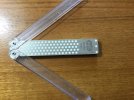With a puck I just dunk it in water when camping - I don't bother with oil. Is not ideal but it does a good enough job preventing plugging. I used to bring a small bottle of mineral oil dual use - a few drops on some duff or a cotton ball to help get the fire started and works well for sharpening.
For all-purpose field use stone, do you prefer puck or more of a traditional rectangular stone? Like I said above, I've had good success with the cheapo Lansky puck on field sharpening axes and other stuff including a mower blade, although if they have a LOT of damage only a bastard file (or a grinder) is really going to work fast. The thing is, it almost seems like the rectangular smaller stone would be easier to use with most normal sized blades, and could still double for use on the large blades. My main reason for using a puck on larger blades is it seemed easier (and safer) to hold onto.

